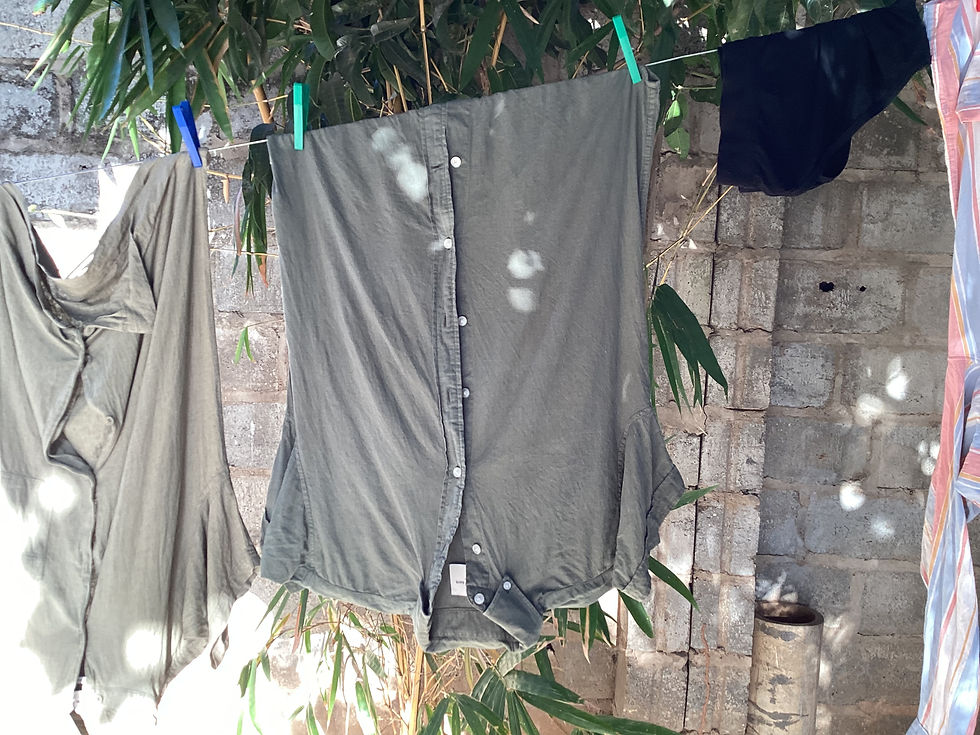ZAMBIA LETTERS, 3
- Ludvig Uhlbors
- 3 juni 2025
- 3 min läsning
Uppdaterat: 28 juni 2025

We fly with Ethiopian Airlines and it is a good experience. The plane is modern and the service is good. Our flight makes several stops and I can imagine that it would be a bit tiring if you do it often but to me it is interesting. Our first stop is in Stockholm to pick up more passengers, then we have another one in Addis Ababa, where we change to another plane of the same size, but a slightly older model. That flight then goes on to take a detour via Harare before arriving in Lusaka.
I read the first scene in “Rannsakningen”, the one that depicts when the guards in Auschwitz tell about how the trains arrived at the camp and how the prisoners were treated upon their arrival. I also see a documentary about Ethiopia on the screen in the back of the seat in front of me. The filmmaker focuses on Ethiopian groups living in more traditional societies. His depiction reminds me a lot of the Nuba people in Leni Riefenstahl's picture books. What these depictions have in common is the interest shown by the photographers in the body cultures and adornments among these peoples. The filmmaker comments that if you live in conditions that are materially simple, the body is perhaps the greatest gift you have received from nature, and to adorn it might be a way of paying tribute to life.
Hanna's residency at LuCAC will be focusing on Makishi. It is a traditional form of full-covering mask used in rites of passages such as weddings and funerals. Tradition says that when you don the mask, you merge with it. Therefore, in a sense, the mask wearer ceases to exist. I read somewhere that the identity of the mask wearer, for this reason, is kept secret from the others.
Victor Mutelekesha welcomes us at the airport. He is a Norwegian-Zambian artist educated at KHiO and living in Oslo, and he works as a volunteer artistic director for the center. During our ride, he mentions the Norwegian artist Jan Groth and this man´s importance to both Victor himself and LuCAC. Victor worked as Jan's assistant for many years and by all accounts, Jan was a very generous person who took on young artists and gave them support. Victor was one of them. When Jan passed away, he left money to Victor, which laid the foundation for the development of the center.
I remember a report I once read, before we started this trip, about the relationship between Zambia and Norway. It was written by a Norwegian ambassador. In it, he describes how Norway and Zambia cooperated over several decades. When Norad was established, Norway decided to invest heavily in the development of this country. At that time, the Zambian regime was socialist and the Norwegian social democratic government was happy to cooperate with it. Norway financed, among other things, the development of the cultural life, the protection of national parks and institutions within the bureaucracy.
Back in the car, we drive past a villa. “Do you know what house that is,” Victor asks? “How much do you know about the history of the ANC? That house was the hiding place for Oliver Tambo, the leader of the ANC during Apartheid. The resistance fighters in South Africa, Zimbabwe and Tanzania had a sanctuary in this country and their fights were organized from that house. Today it is a museum.” I make a memo note of it and decide that I must visit it at a later opportunity.
In our conversation, Victor also mentions Dag Hammarskjöld. “All Zambian children know of him,” he says. “We learn about him in school. Hammarskjöld’s plane crashed in Zambia.”
LuCAC is impressive. There is a restaurant on the premises. They have a library, a gallery, studios and a two-storey house where we will be staying. On the lower floor our hosts have set up an extra bed and the house is equipped with bathrooms both upstairs and downstairs. There is also a balcony facing south.
During the tour of the premises we are introduced to Rachel, who works with the centre, and to several local artists who have residence in the centre, or who have had it in the past and now continue to use its services.
Our kitchen is also home to many large spiders and this causes some distress among us but they are completely harmless.




Kommentarer